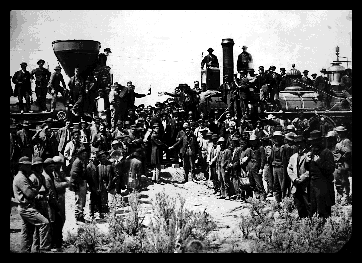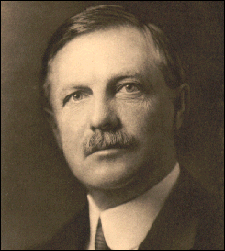http://www.over-land.com/
1865-1877 Reconstruction of the South
1865 - Lincoln fatally shot at Ford's Theater by John Wilkes Booth. Vice President Johnson sworn as president. He will fight the Radical Republicans1865 Amendment XIII: Slavery is abolished and prohibited throughout the States.
1865 Ku Klux Klan created
1865-66 Black Codes before Radical Republican Reconstruction, held the freedmen on the plantations where they had worked as slaves.
1866 - The Civil Rights Act in theory gave the right to vote to Blacks.
1866 > 1868 Amendment XIV: This amendment creates national citizenship for all males, therefore to Blacks. Along with amendments XIII (abolition of slavery) and XV (the suffrage i.e. the right to vote cannot be denied on account of race, color, or previous condition of servitude) it might be looked upon as the peace settlement forced upon the South.
1868 (feb.) - President Johnson narrowly misses impeachment.
1869>1870 - Amendment XV grants the franchise (the right to vote) to freedmen .
1869 - Ulysses Grant is President.
1869 The first transcontinental railroad
1872 - Congress gives amnesty to most Confederates.
1877 - End of Reconstruction.
The conquest of the West
1869 The first transcontinental railroad
Grand Teton (Wyoming)
The Rockies
 |
|
1876 Little Big Horn : General Custer defeated by Indians.
1876 Invention of the telephone by Alexander Graham Bell.
1878 Edison invents the electric bulb.
1882 Chinese Exclusion Act
1887 General Allotment Act of 1887 or the Dawes Act
Later on, the old idea of assimilation reappeared. “Carl Schurz, for instance, had believed, already in the 1870’s, that Indians could be regenerated and assimilated , if their tribalism were broken up. The Dawes Act of 1887 had been based on such premises (Merk 242).”The General Allotment Act of 1887 or the Dawes Act as it is also called, resulted in the sale of 90 million acres of the 140-million-acre Indian estate and allowed low-cost grazing leases on the remaining reservation rangelands.
With the Dawes Act, Congress provided for the granting of landholdings (allotments, usually 160 acres/65 hectares) to individual Native Americans, replacing communal tribal holdings. Sponsored by U.S. Senator H. L. Dawes, the act sought to absorb tribe members into the national body politic. Allotments could be sold after a statutory period (25 years), and “surplus” land not allotted was opened to settlers. Within decades following the passage of the act the vast majority of what had been tribal land in the West was in white hands. (http://www.infoplease.com/ce6/history/A0814821.html) 11nov. 2000.
1890 End of the frontier.
1890 Wounded Knee Massacre: last Indian
rebellion. Chief Big Foot and his tribe massacred.

The historian Frederick Jackson Turner's most famous essay, "The Significance of the Frontier in American History," was read before the American Historical Association at the Chicago World's Columbian Exposition in 1893.
"[T]he powerful romantic attraction of primitivism, dating back at least to Rousseau [was] the belief that the best antidote to the ills of an overly refined and civilized modern world was a return to simpler, more primitive living. In the United States, this was embodied most strikingly in the national myth of the frontier. The historian Frederick Jackson Turner wrote in 1893 the classic academic statement of this myth, but it had been part of American cultural traditions for well over a century. As Turner described the process, easterners and European immigants, in moving to the wild unsettled lands of the frontier, shed the trappings of civilization, rediscovered their primitive racial energies, reinvented direct democratic institutions, and thereby reinfused themselves with a vigor, an independence, and a creativity that were the source of American democracy and national character." (William Cronon, "The Trouble with Wilderness or, Getting Back to the Wrong Nature," Cronon, William ed. Uncommon Ground: Toward Reinventing Nature. New York: W.W. Norton, 1995.)
1896 Plessy vs. Ferguson : the Supreme Court
sets forth the doctrine of "equal but separate facilities" which makes
segregation legal.
1898 - The signing of the Treaty of Paris ended the Spanish-American
War. Spain recognised the independence of Cuba and sold Guam, the
Philippines and Puerto Rico to the United States for US$20 million.
Source: Wikipedia
1902 Reclamation Act
1919 Prohibition enforced (Amendment XVIII). Prohibition is the forbidding by law of the making or sale of alcoholic drinks.
1920 Amendment XIX: Female suffrage: all American women are given the right to vote.
1920S The roaring twenties

Auto workers at a Ford plant, 1927.
The New York Times Photo Archives.
1929 Beginning of the Great Depression: Black Thursday at Wall Street (24th October).
1933 - Prohibition Amendment is repealed (Amendment
XXI)
1933 The New Deal is
launched : The Tennessee Valley Authority improves the economy of the Tennessee
Valley.
Suggested movie
1941-1945 SECOND WORLD WAR
1941 Japanese attack Pearl Harbor (Dec. 7).
1945 Atom bombs dropped on Hiroshima and Nagasaki.
1946-1960 THE YEARS OF AFFLUENCE
1947 Marshall Plan launched: twelve billion dollars lent or given to European countries by 1951 for recovery.
1950-1953 Korean war
1950 Senator Joseph R. McCarthy initiates an anti-communist campaign.
1953-1961 DWIGHT D. EISENHOWER
1957 Peak of Baby Boom
1954 "Brown vs. Topeka" (Separate but equal doctrine [1896 Plessy vs. Ferguson] overturned).
The prevailing policy especially in education was the famous "separate but equal" doctrine. (cf. 1896) This was the doctrine that was ruled out in a famous case that the Supreme Court had to examine in 1954. Chief Justice was Earl Warren, who possibly stands out as one of the most famous American Chief Justices along with John Marshall . The case judged in 1954 was called "Oliver Brown et al. vs. Board of Education of Topeka, Kansas." Chief Justice Earl Warren in his conclusion delivered the unanimous opinion of the court "that in the field of public education the doctrine of "separate but equal" has no place. Separate education facilities are inherently unequal." In other words, segregation i
1961President JOHN F. KENNEDY 1961-1963
1961President Kennedy calls for a “New Frontier”1964 Civil Rights Act bans discrimination in voting, jobs, and public accommodations.
1961-1973 The Vietnam War
1962 Cuban missile crisis
1963 March on Washington
1963 November : President J.F.Kennedy is assassinated in Dallas.
1973 Viet Nam Peace Pact signed in Paris.
1973 OPEC quadruples price of oil ,which leads to the energy crisis of the seventies.
1974 President Nixon resigns on August 9th following the Watergate scandal so as not to be impeached. Vice-President Gerald Ford takes over.
1977-1981 JIMMY CARTER
1979 Hostages seized in Iran
1981-1989 RONALD REAGAN
1981 Hostages return home.
The Clinton years
See this link

About G.W. Bush